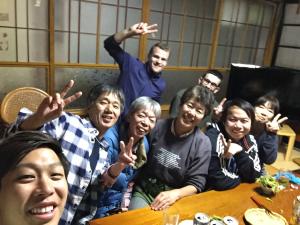The 2015 JET Study Tour to the Aizu region was an eye opening experience. The tour was educational, but at the same time, it was also enjoyable. I was able to meet older JET participants and reconnect with newer JET participants that I met over the last two months that I’ve been in Fukushima.
Before coming to Fukushima, I had my doubts about the safety of Fukushima. Most of my worries were about the nuclear levels in the prefecture. Is the food safe to eat? Is the water safe to drink? Are the background radiation levels too high? I’m sure that most people moving to Fukushima contemplate these questions. This is due to the news and information that we see abroad. Most of the time, we can only get information that will catch the attention of the readers; sadly the information often is negative and inaccurate.
On the Study tour we visited places that informed us of the current process that food is put through and the statistics of rejected foods; we visited one of the many rice inspection sites in Fukushima and the Agricultural Technology Centre. Fukushima was once known for its agriculture, but after the nuclear meltdown, the industry took a big hit, because people are avoiding products that are grown in Fukushima. In order to combat this mindset, strict regulations were put in place to assure the safety of the agricultural products in the prefecture. However, the stigma of “Products of Fukushima” are not safe still exists with many Japanese today.
When we visited the rice inspection site, we saw the rigorous process which all rice is put through in order to reach the store shelves. One of the amazing parts of the process is that every bag of rice is inspected, then a unique QR code, a barcode that can be scanned with smart phones, is assigned to each bag. Once scanned, the unique QR code will give you all the information that you could ever want from that specific bag of rice: when it was harvested, where it is from, and other basic information. Of course, the data that most people are interested in is the radiation levels, which is also included. Now, you can be assured that your rice is within Japan’s regulated radiation limit. Statistically, 2 out of 11,009,627 bags of rice were found to be over the limits in 2014. Another place that we visited was the Agricultural Technology Centre, where we were provided with the statistics for the food products from all of Fukushima. In 2015 from April to September, there were 13,181 samples of foods that were tested and only 15 samples were found to be over the allowed limits, majority of the sample that didn’t pass inspections coming from wild mountain herbs, mushrooms, and seafood. Another thing to point out is that the allowed limits are 10 times stricter than the United States standards.
One of the touristy places that we visited was Tsurugajo Castle. This trip was my first time in Aizu, so a visit to the famous Tsurugajo castle was necessary. There is so much interesting history about the castle that is shown throughout the castle. At the top of the castle there is a breathtaking view that you should not miss. Tsurugajo and the Aizu region were popular spots for school trip throughout Japan, but after March 11, 2011, the number of school trips, and regular visitors, drastically dropped. It’s a shame that people are avoiding this area, because it is a beautiful place with history.
The Aizu region and Fukushima in general, are truly amazing places and should still be visited by people in Japan and around the world. Fukushima is slowly rebuilding after March 11, 2011 and it has been tough, but Fukushima is working hard to get back to the level that it was once at. 
|








